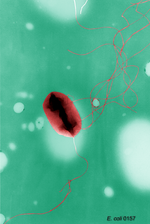鞭毛
鞭毛(flagellum)是很多单细胞生物和一些多细胞生物细胞表面像鞭子一样的细胞器,用于运动及其它一些功能。
| 鞭毛 | |
|---|---|
 革兰氏阴性菌细菌鞭毛的结构。 | |
 | |
| 标识字符 | |
| MeSH | D005407 |
| TH | H1.00.01.1.01032 |
| FMA | FMA:67472 |
| 《解剖学术语》 [在维基数据上编辑] | |

一个微生物可能有一个到多个鞭毛。在三个域中,鞭毛的结构各不相同。细菌的鞭毛是螺旋状的纤维,像螺丝一样旋转,属于生命系统中的旋转运动。古菌的鞭毛表面上和细菌的类似,但很多细节不同,和细菌的鞭毛可能也不是同源的。真核生物,比如动物、植物、原生生物细胞的鞭毛是细胞表面结构复杂的突出物,像鞭子一样来回抽打。
类型
编辑鞭毛可分为三种类型:细菌鞭毛,古菌鞭毛,和真核生物的鞭毛。
真核生物的鞭毛含有动力蛋白和微管,以弯曲甩动的方式获力。细菌和古菌的鞭毛中不含有动力蛋白或微管,以旋转运动运行。[1]
其它的区别包括:
细菌鞭毛
编辑不同种类的细菌有不同的数目的鞭毛。Monotrichous细菌有一个单一的鞭毛(如霍乱弧菌)。 Lophotrichous细菌有多种鞭毛设在细菌同样的表面上,而协调一致地行动,将细菌进往单一的方向前进。
一些细菌,如selenomonas ,鞭毛有组织外胞体。
古菌鞭毛
编辑此条目需要精通或熟悉相关主题的编者参与及协助编辑。 (2015年12月14日) |
古菌的鞭毛表面上看起来类似细菌的鞭毛。但在20世纪90年代,研究人员曾发现了古菌和细菌鞭毛的具体不同,其中包括:
真核生物鞭毛
编辑真核生物的鞭毛是由9+2的微管构成,利用动力蛋白用ATP拉动微管摆动。 鞭毛具有抗原性,可诱使宿主产生抗体。
参见
编辑参考文献
编辑- ^ Alberts, Bruce. Molecular biology of the cell Sixth. New York, NY. 2015: 942. ISBN 9780815344643.
- ^ Silverman M, Simon M. Flagellar rotation and the mechanism of bacterial motility. Nature. 1974, 249 (452): 73–74. PMID 4598030. doi:10.1038/249073a0.
- ^ Meister GLM, Berg HC. Rapid rotation of flagellar bundles in swimming bacteria. Nature. 1987, 325 (6105): 637–640. doi:10.1038/325637a0.
- ^ Berg HC, Anderson RA. Bacteria Swim by Rotating their Flagellar Filaments. Nature. 1973, 245 (5425): 380–382. PMID 4593496. doi:10.1038/245380a0.
- ^ Jahn TL, Bovee EC. Movement and Locomotion of Microorganisms. Annual Review of Microbiology. 1965, 19: 21–58. PMID 5318439. doi:10.1146/annurev.mi.19.100165.000321.
- ^ Harshey RM. Bacterial Motility on a Surface: Many Ways to a Common Goal. Annual Review of Microbiology. 2003, 57: 249–273. PMID 14527279. doi:10.1146/annurev.micro.57.030502.091014.
- ^ Ng SY, Chaban B, Jarrell KF. Archaeal flagella, bacterial flagella and type IV pili: a comparison of genes and posttranslational modifications. J. Mol. Microbiol. Biotechnol. 2006, 11 (3–5): 167–91. PMID 16983194. doi:10.1159/000094053.
- ^ Metlina AL. Bacterial and archaeal flagella as prokaryotic motility organelles. Biochemistry Mosc. 2004, 69 (11): 1203–12. PMID 15627373. doi:10.1007/s10541-005-0065-8.
- ^ Jarrell. Archaeal Flagella and Pili. Pili and Flagella: Current Research and Future Trends. Caister Academic Press. 2009. ISBN 978-1-904455-48-6.